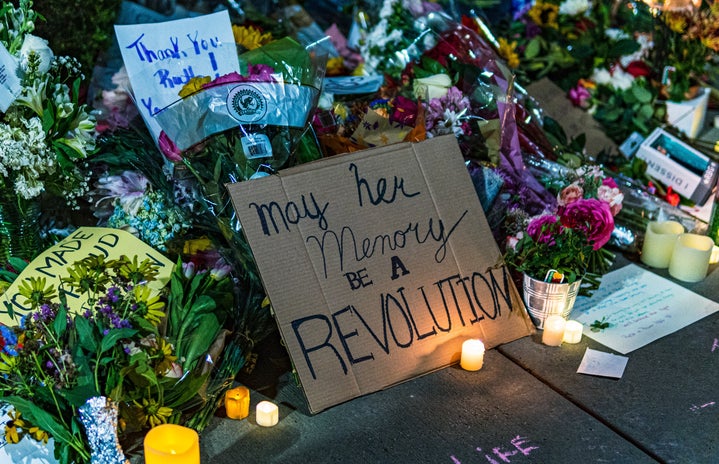On September 18th, 2020, America lost acclaimed activist and supreme court justice Ruth Bader Ginsburg. Justice Ginsburg’s impact can never be appropriately portrayed through words. She actively fought for women’s rights, for equal healthcare opportunities, gender equality, American civil rights, and a myriad of other noble causes. The impact she had on this country in her 87 years of life is astonishing. She will never be forgotten.
Ginsburg was born March 15th, 1933 in Brooklyn, New York. She grew up in a Jewish household. Nathan and Cecelia Ginsburg, Justice Ginsburg’s parents, were not wealthy people; they were of the working class and had some monetary struggles. Ginsburg’s mother held a job to help put Justice Ginsburg’s brother through college. This was monumental because it was not the “norm” for married women to work.
Ginsburg, inspired by her mother’s hard work, pushed herself in her studies and eventually attended college at Cornell University on a full scholarship. Ginsburg often said her mother was one of her biggest inspirations. Unfortunately, the day before Ginsburg’s high school graduation, her mother passed away after struggling with cancer for four years. Ginsburg aimed to carry her mother’s legacy on into her work, and we can all say that her mother would be immensely proud.
RBG met her husband at Cornell; Martin D. Ginsburg was another law student at Cornell and the two eventually enrolled in Harvard University Law School. A new mother and a wife with a husband overseas, Ginsburg had to learn quickly how to balance life as a student as well.
Ginsburg was actually one of eight women amongst 500 males in the Harvard law program. She was also the first female member of the Harvard Law Review, a legal journal originating at Harvard. At home, Ginsburg took care of her newborn baby, Jane, and her husband who had recently been diagnosed with testicular cancer. Martin Ginsburg eventually graduated Harvard Law School and took a job in New York City; he moved the family there and RBG continued her law education there, graduating with the class of 1959 at Columbia Law School.
After she graduated, Ginsburg struggled with finding steady work because of her gender and because she was a mother. It took a tremendous amount of time and effort for her to find a lawyer position, but one of her professors from Columbia advocated for her and eventually found her a position as a clerkship for U.S. District Court Judge Edmund Palmieri. She eventually was asked to be an assistant professor at Rutgers School of Law. However, she was asked to accept a lower salary because of her husband’s high paying job.
While a professor, Ginsburg became pregnant with her second child. Fearful she would be fired for her pregnancy, she wore oversized clothing to hide her stomach. This, believe it or not, was successful and she was tenured at Rutgers in 1969.
Teaching at Rutgers began her fight for gender equality. It was a lesson she was asked to introduce to her classes and she became very involved. In 1971 she published a couple of law review articles about women’s liberation and took up teaching a seminar on gender discrimination. This began her partnership with the American Civil Liberties Union (ACLU), eventually leading to her being in the founding group of ACLU’s Women’s Rights Project. Obviously from here, she hit the ground running. She fought in the supreme court for gender equality and won five cases on the issue in the 1970s.
In 1980, President Jimmy Carter appointed Ginsburg to the U.S. Court of Appeals for the District of Columbia in Washington D.C.. RBG had a large role in the Roe v. Wade case. This is one of the most famous cases which aimed to make abortion a constitutional right for women.
She wrote the majority’s opinion in U.S. v. Virginia. This was a case that stated that the “men only” admission policy of Virginia Military Institute violated the equal protection clause. Ginsburg believed that politics were “gender blind;” everyone deserves to have their voice heard.
During her activism for gender equality/women’s rights, she (obviously) faced strong criticism. She had harsh opinions and worded them strongly. The people had equally strong words to say back, but she continued. She also had major roles in the following supreme court cases: Gonzales v. Carhart, Ledbetter v. Goodyear Tire, Shelby County v. Holder, and Burwell v. Hobby Lobby Stores, Inc.
In 2010, Ginsburg became the most senior justice within the Liberals. She played a role in the Affordable Care Act cases and posed “constitutional challenge” to Obamacare. She was very involved in bringing affordable healthcare to the American people, believing everyone was deserving of it.
Ginsburg had watched her mother fight and lose to cancer, her husband was a cancer survivor, and she herself survived cancer twice, so the fight for healthcare was an important one in her eyes because of the personal connections she had.
These are only the highlights of RBG’s accomplishments. She dedicated her life to fighting for everyone else’s. The legacy she left will never be forgotten and it is now our turn to take what she built for us and make our country better.
Rest in Justice, Ruth Bader Ginsburg.
“I would like to be remembered as someone who used whatever talent she had to the very best of her ability”-RBG
References
https://www.history.com/topics/womens-history/ruth-bader-ginsburg
https://www.britannica.com/biography/Ruth-Bader-Ginsburg
https://www.nytimes.com/2020/09/18/us/ruth-bader-ginsburg-dead.html


